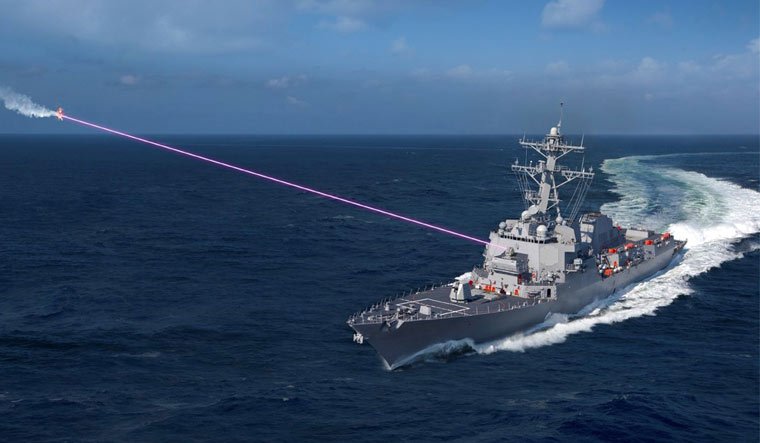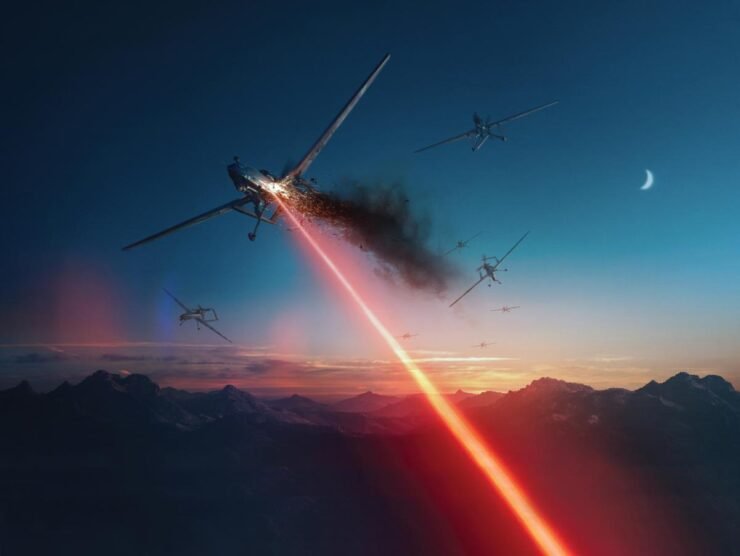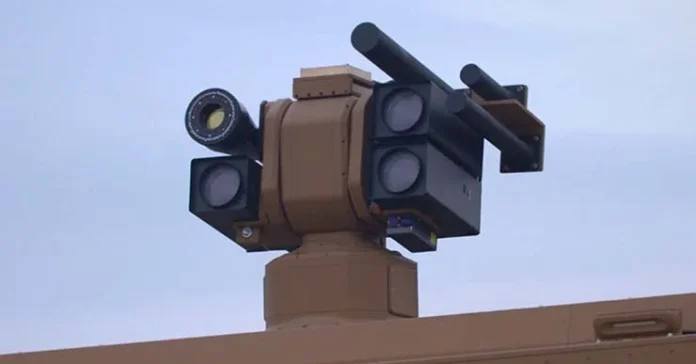In layman’s terms, Directed-energy weapons (DEW) are meant to destroy or damage the given target using focussed energy utilising particle beams, microwaves or lasers. In several media reports, DEWs are often noted as laser weapons.
Directed-energy weapons possess many advantages over conventional munitions. For instance, they transmit a lethal force at the speed of light, i.e. around 3,00,000 kilometres per second. Secondly, the atmospheric drag, and the constraining effects of gravity, do not affect the beams of these weapons. Third, these weapons are extremely precise. Fourth, varying the intensity and type of energy delivered against targets can change the effects of DEWs.
The US is at the forefront of researching these weapons to utilise them for countering a variety of munitions. Reports indicate that Turkey and Iran also have these weapons in active use. In fact, Turkey even claimed to shoot down a drone with its laser weapon- ALKA. Moreover, India, Pakistan, China, Russia, Germany, and France are also working on military-grade DEWs.With big players involved in developing this technology comes a large market size. Data suggests that the market was worth a whopping $4.1 billion in 2020.
The weapon that India is developing in this arena is called Directionally Unrestricted Ray-Gun Array (DURGA II). It is one of the products in the multi-billion dollar market.
DURGA II
The classified project, DURGA II, is a 100-kilowatt lightweight DEW that will soon be in the hands of the Indian Army, according to a service official who spoke to the news agency Defence News last year. Scientists, on the other hand, have noted that this weapon system is set to be integrated with sea, air and land-based platforms as well.

The lead laboratory in developing laser weapons, Laser Science and Technology Centre at Delhi, highlighted the range of the enigmatic gun, saying that “the center has to this point made a 25-kilowatt laser that can target a ballistic missile during its terminal phase at a maximum distance of 5 kilometres.”
However,DURGA is not a new project. The existence of this project has been noted in various reports over the course of the past two decades, since the early 2000s. Until 2008, reports indicated that there was little progress with the project. However, back in 2017, in Chitradurga, the Defence Research and Development Organisation’s (DRDO) testing of a 1KW truck-mounted laser weapon at a test facility in the presence of the then defence minister Arun Jaitley is viewed as a part of project DURGA. At this point, the confirmed range of the weapon was at least 250 metres. Since then, there appears to have been a substantial capability enhancement, evident in the DEW now possessing a 25-kilowatt laser gun.
While the possibility of low-cost per hit, great speed, and high precision makes the weapon extremely potent, several drawbacks need to be addressed before it becomes viable for use.
Developmental Challenges for DEWs
Such high-power laser weapons are not easy to develop. For starters, providing adequate power to the systems is a significant challenge. The availability of a significant power source can not be guaranteed in all pressing scenarios that might arise on the battlefield. Another issue emerging as a corollary of massive energy usage is heating. The amount of heat generated acts as a substantial roadblock to an efficient deployment of DEWs. The heat generated during the operation of a DEW impacts power consumption.

Additionally, it also affects the overall size and weight of the system. The challenge in this regard is the creation of a cooling mechanism. There is another issue with lasers. When they travel towards a target, laser beams come across atmospheric effects such as water vapour, dust, pollutants etc., that can distort it by absorbing or refracting energy and lead to loss of focus. Thus, it is also necessary to ensure that the beam generated from the DEW is focused on the given target. This involves a lot of innovation in creating lenses that can focus the beam- the department of optronics or optoelectronics.
Other considerations are also at play here. For instance, a laser can only stop a missile if it generates enough energy to slash through its electronics package. An adversary could add a harder, thicker outer shield layer, thus defending it from DEWs. Moreover, since a laser weapon can only focus on one target at once, a volley of missiles could overwhelm the DEWs defence. Plus, targeting low-flying cruise missiles that are often out of sight would also be problematic. Heat-seeking kinetic interceptors do not face this issue.
– The writer is an Aerospace and Defence Analyst & Director ADD Engineering Components (India) Pvt Ltd (An Indo- German Company).
-The author is a Defence, Aerospace & Political Analyst based in Bengaluru. He is also Director of ADD Engineering Components, India, Pvt. Ltd, a subsidiary of ADD Engineering GmbH, Germany. You can reach him at: girishlinganna@gmail.com. The views expressed are personal and do not necessarily carry the views of Raksha Anirveda






